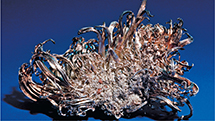CHAPTER 4 Study Guide
4.1 Studying Atoms
 Key Concepts
Key Concepts
Dalton proposed the theory that all matter is made up of individual particles called atoms, which cannot be divided.
Thomson's experiments provided the first evidence that atoms are made of even smaller particles.
According to Rutherford's model, all of an atom's positive charge is concentrated in its nucleus.
Vocabulary
nucleus, p. 105
4.2 The Structure of an Atom
 Key Concepts
Key Concepts
Protons, electrons. and neutrons are subatomic particles.
Protons, electrons, and neutrons can be distinguished by mass, charge, and location in an atom.
Atoms of different elements have different numbers of protons.
Isotopes of an element have the same atomic number but different mass numbers because they have different numbers of neutrons.
Vocabulary
proton, p. 108
electron, p. 108
neutron, p. 109
atomic number, p. 110
mass number, p. 110
isotopes, p. 112

4.3 Modern Atomic Theory
 Key Concepts
Key Concepts
An electron in an atom can move from one energy level to another when the atom gains or loses energy.
Scientists use the electron cloud model to describe the possible locations of electrons around the nucleus.
An electron cloud is a good approximation of how electrons behave in their orbitals.
The most stable electron configuration is the one in which the electrons are in orbitals with the lowest possible energies.
Vocabulary
energy levels, p. 114
electron cloud, p. 116
orbital, p. 117
electron configuration, p. 118
ground state, p. 118
Thinking Visually
Table of Properties Use information from the chapter to complete the table below.
|
Particle |
Proton |
Electron |
Neutron |
|---|---|---|---|
Symbol |
a. |
e− |
n |
Relative charge |
1+ |
b. |
c. |
Relative mass |
d. |
e. |





